We’ve decided that while we’re still relatively young, we’re going to take some time off to enjoy our son and live on a sailboat.
Saturday, November 19, 2011
Where have we been?
Wednesday, August 3, 2011
Web Site Issues
UPDATE 5:40 PM: I have found a nice java app to modify for our photo gallery. Check out the latest photos at http://www.svmirasol.com/photos_current.htm. I finished updating St. Vincent & the Grenadines '11, and both Grenada pages.
Monday, July 25, 2011
Dominica 2011

 Once out of town, the roads are mostly unimproved, single lane with enough extra space for the occassional oncomming car to pass you if you both hug the shoulder... really hug it. As for guardrails, generally there are none in spite of the fact that the road may be carved out of the side of nearly vertical mountainside. It's prudent to sound your horn as you approach a blind curve and listen for an answer so you can swing over in time.
Once out of town, the roads are mostly unimproved, single lane with enough extra space for the occassional oncomming car to pass you if you both hug the shoulder... really hug it. As for guardrails, generally there are none in spite of the fact that the road may be carved out of the side of nearly vertical mountainside. It's prudent to sound your horn as you approach a blind curve and listen for an answer so you can swing over in time.The main roads of the island are in the process of being improved to undivided 2 lane highways by the Chinese. The Chinese government pours a lot of resources into Dominica and other Caribbean islands in order to secure political votes in the UN. There are also prominent donations by Chavez of Venezuela in the form of schools and other public facilities.
 Rosseau, our destination in Dominica, is the largest town on the island and is located on the southern end of the west coast. There are many mooring balls for hire, which is good as the anchorage is quite deep and holding is rather poor. On arrival we radioed Sea Cat, one of the two prominent boat vendors in Rosseau, to arrange for a mooring. Once tied up to the mooring, I hired a boat vendor to give us a lift in his brightly colored open boat to the customs office. The anchorage had a 2 foot chop so the ride to customs was much more comfortable in a heavy deep-V fiberglass boat than in my little dinghy.
Rosseau, our destination in Dominica, is the largest town on the island and is located on the southern end of the west coast. There are many mooring balls for hire, which is good as the anchorage is quite deep and holding is rather poor. On arrival we radioed Sea Cat, one of the two prominent boat vendors in Rosseau, to arrange for a mooring. Once tied up to the mooring, I hired a boat vendor to give us a lift in his brightly colored open boat to the customs office. The anchorage had a 2 foot chop so the ride to customs was much more comfortable in a heavy deep-V fiberglass boat than in my little dinghy.Customs is very easy. You clear in and out at the same time, there is only one short form to fill out, and the fee is only 5 Eastern Carribean Dollars (about $2 US) per person. This is refreshing after the numerous forms and high fees required by The Bahamas, The British Virgin Islands and Antigua.
 While in Rosseau, we joined Sea Cat for a land tour. We were introduced to Octavious (Sea Cat) by Randy and Susan Williamson of Windward Passage during our last trip down island and were eager for a repeat. We saw several of the highlights of the last tour - Emerald Falls, Trafalgar Falls, and the Carib Indian villiage (not in a touristy enclave but friends of Octavious who welcomed us into their homes and showed us how they live). While there, we were shown how much of the food they needed could be found in their "back yard". There were coconuts, mangos, breadfruit, papayas, cacao trees, many herbs, and lots of chickens. Fish were brought up into the mountains by the local fishermen. The fish and chicken were smoked over home made charcoal as a preservative as they had no refrigeration.
While in Rosseau, we joined Sea Cat for a land tour. We were introduced to Octavious (Sea Cat) by Randy and Susan Williamson of Windward Passage during our last trip down island and were eager for a repeat. We saw several of the highlights of the last tour - Emerald Falls, Trafalgar Falls, and the Carib Indian villiage (not in a touristy enclave but friends of Octavious who welcomed us into their homes and showed us how they live). While there, we were shown how much of the food they needed could be found in their "back yard". There were coconuts, mangos, breadfruit, papayas, cacao trees, many herbs, and lots of chickens. Fish were brought up into the mountains by the local fishermen. The fish and chicken were smoked over home made charcoal as a preservative as they had no refrigeration.The villagers offered us samples of the smoked fish. Pulling the meat off of a fish carcass while holding on to the head or tail took a little getting used to, but it was delicious. Quinn loved it and asked for more. Octavious got a huge grin and returned with half a fish all for Quinn, who devoured it, picking the bones. The smoking clearly works as I believe the fish we sampled was smoked days ago and stored in hot, humid rainforest conditions without packaging or refrigeration.
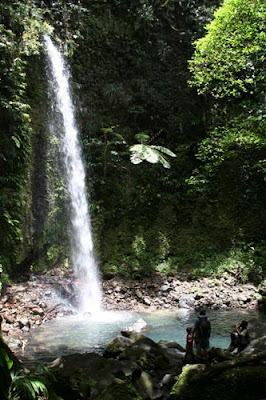 In addition to the familiar stops from last year, Sea Cat took us to a pair of waterfalls that required some serious scrambling. We found ourselves climbing up 40 foot, 70 degree inclines with the help of a rope where tree vines and roots were insufficient. Other times we were walking on paths no more than a foot wide with a nearly sheer drop into the river gorge on one side. These were virtually unimproved paths through the rain forest and it was a phenominal experience. Quinn did fantastic as usual. He listened and moved cautiously (most of the time) and managed without any problems or nervousness. When we return to land I'm going to have my hands full building a tree house or backyard play set that will interest him after having hiked and climbed through Caribbean rain forests and jungles!
In addition to the familiar stops from last year, Sea Cat took us to a pair of waterfalls that required some serious scrambling. We found ourselves climbing up 40 foot, 70 degree inclines with the help of a rope where tree vines and roots were insufficient. Other times we were walking on paths no more than a foot wide with a nearly sheer drop into the river gorge on one side. These were virtually unimproved paths through the rain forest and it was a phenominal experience. Quinn did fantastic as usual. He listened and moved cautiously (most of the time) and managed without any problems or nervousness. When we return to land I'm going to have my hands full building a tree house or backyard play set that will interest him after having hiked and climbed through Caribbean rain forests and jungles!
Monday, July 4, 2011
We're here
The website has been updated with photos and our position in Grenada. I've been working on upgrading the google maps api used on the position and log pages as apparently, google no longer supports the old api that most of our pages use. It's taking some time and the only pages I have finished thus far are the current position and the 2011 Windwards page.
Monday, June 6, 2011
Southern Guadeloupe

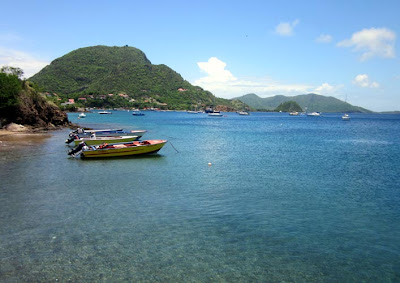

Wednesday, June 1, 2011
Deshaies River Scramble


Guadeloupe - Arrival in Deshaies
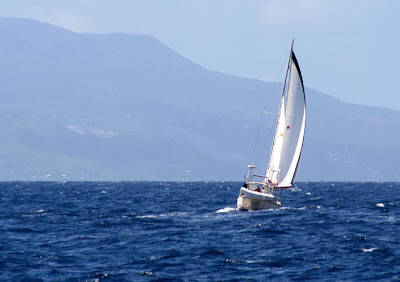
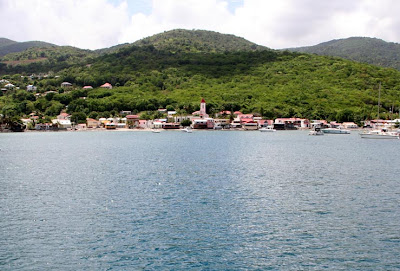
Blog Catch Up Day
Tuesday, May 31, 2011
Antigua
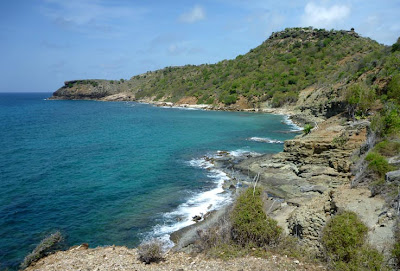 Our original plans were to sail direct for Guadeloupe from the BVI, a passage requiring two nights at sea. However, since we're not in a hurry and the winds were right for it, we decided on stopping in Antigua for a few days. This shortened the trip from BVI to only one overnight, and then a day sail to Guadeloupe.
Our original plans were to sail direct for Guadeloupe from the BVI, a passage requiring two nights at sea. However, since we're not in a hurry and the winds were right for it, we decided on stopping in Antigua for a few days. This shortened the trip from BVI to only one overnight, and then a day sail to Guadeloupe.
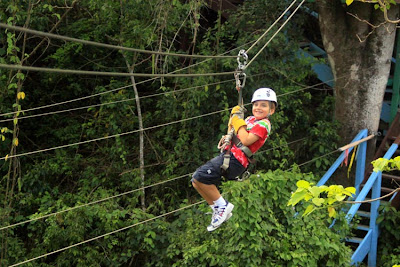
Tuesday, May 24, 2011
Good Rum = Bad Spelling
Friday, May 20, 2011
British Virgin Islands - Disney Land for Sailors?
We like the BVI. It has a lot to offer. There are a dozen or so islands and cays surrounding the Sir Francis Drake Channel, anchored by Tortola and Virgin Gorda. This layout provides for fairly sheltered sailing, line-of-site navigation and plenty of destination anchorages to keep you interested for a while. Add in the great diving, snorkeling, and rich history typical of the Caribbean islands, it's a fun place to be.
But that's the catch. It's too convenient! The sailboat charter industry has blossomed here like no place in the Caribbean. Folks looking for an ideal sailing vacation can fly in for a week and spend a few hours a day sailing from anchorage to anchorage - each with entertainment ashore and beautiful surroundings. The locals have embraced this bounty and make the most of it. Just about all anchorages have a bar/restaurant close at hand, along with the ubiquitous gift shop. In all but the largest anchorages, the good and even fair anchoring ground has been peppered with mooring balls, leaving only marginally viable anchoring ground if you aren't willing to pay the $25 TO $30 per night to use the moorings (or trust your anchor better than their moorings).
To be fair, the moorings have their place. Given the huge number of charter boats in service here, the moorings allow an anchorage to accommodate many more boats than if everyone were anchored. Also, anchoring safely while avoiding damage to coral or grass beds is an acquired skill which most chatterers have not had the opportunity to develop. In the party party party atmosphere of many of the chartering groups, it's all they can do to safely tie up to the mooring ball and get ashore without a mishap. After all, they aren't aboard their floating home containing all their worldly possessions. They're on a rental boat for a fun vacation. So they party and we try to stay out of their way, lend a hand where needed, retrieve the odd escaped dinghy, and enjoy the show.
Sunday afternoon is always fun in an anchorage with a sundowner in hand watching the newly arrived charterers pick up a mooring ball for the first time of the vacation. We make a point of being on board around that time.
So, the BVI has its place as a sailing destination. For the charterer, it's a great destination for the newbie or the moderately experienced. For a cruiser, it's a good place to rest a bit after the thorny path or a long offshore passage from the US. But for this cruiser, it's a little surreal... like a Disney Land for sailors. Time to head down island!
Wednesday, May 18, 2011
Off to the British Virgin Islands - April 23rd
Monday, May 16, 2011
Quiet Night On Anchor - South Coast of Puerto Rico
Ponce, Puerto Rico
Saturday, May 14, 2011
Do You Smell Oil?
Thursday, May 5, 2011
Coasting at Dawn

My Discovery of Mofongo
One evening we ate a local family-run restaurant and had a great meal. I ordered Mofongo, mostly because it was fun to say "Mofongo, por favor" after I'd had a few Medallas. Mofongo is a dense pile of mashed plantains and garlic, stuffed with your choice of seafood, chicken, pork or "meat"(beef). It is usually served smothered in a delicious sauce with rice and beans on the side. I had a shrimp mofongo that night and it was delicious. It turns out that Mofongo is a dish found on most menus in Puerto Rico, and each one is a little different. I had fun sampling Mofongo as we worked our way along the Puerto Rican coastline. It was never a disappointment.
We discovered there would be a big fish festival in town in a few days, which sounded too good to miss, but we didn't want to stay in the marina a full week. We arranged dockage at the marina for the festival and then moved south along the coast to Boquerone. Boqerone is a town that caters to the weekend party crowd, and was pretty quiet the two weekday nights we anchored there. The anchorage is quite large and about a third of the boats seemed to be anchored there on a permanent basis. A few, I'm certain, had marine growth securing them them firmly to the ground, making their anchor superfluous.
After two nights in Boquerone we returned to Puerto Real for the fish festival. It was a lot of fun. Street vendors, music, dancers, etc. I bought Quinn a couple of boxes of party snaps - the little harmless fire crackers that make a snap when you throw them on the ground - which he loved. He was delighted when he could share them with a little girl he met at the marina.

Kathy and John on Oceana caught up with us while we were in Puerto Real for the Fish Festival. Their short visit to the Dominican Republic was a great success, and they convinced us to visit the DR on our way back north in 2012.
The next day we left Puerto Real at dawn and returned to Boqueron, this time accompanied by Oceana. We spent a night in Boquerone, and then moved a little south to El Combate. The weather was blustery and rainy so we decided to relax on board Mirasol for the remainder of the day instead of heading ashore.
Again at dawn we departed El Combate and headed south to the south western cape of Puerto Rico, Cabo Rojo. There we found a large inviting anchorage... littered with fish trap floats. We spent about a half hour picking around the small bay and neither we nor Oceana were able to find somewhere to drop anchor without being surrounded by the fish traps. Our plans being to leave before dawn, we didn't want to be picking our way through fish traps in the dark. Instead, we elected to return to El Combate for the night.
Friday, April 29, 2011
Puerto Rico - Arriving on the West Coast
On arriving in Puerto Rico, I found I liked it immediately. The rich green rolling hills climbing towards the volcanic peaks in the eastern half of the island was a great contrast to the flat landscape of Florida, The Bahamas, and the Turks and Caicos. The people were also very welcoming, as I worked out how to clear in.
Being a US Territory, clearing in to Puerto Rico for a US Citizen is pretty straight forward. However, if you don't participate in the US Customs Local Boater system, it's less convenient than most Carribbean ports of call. US Customs is located downtown in Mayaguez, about 15 miles north of Puerto Real. We chose not to stop in Mayaquez to clear in because it is a commercial port and not very comfortable for small vessels like Mirasol. Instead, the procedure is to call an 800 number on arrival and provide your information over the phone. I tried to do this with my satellite phone, but the phone system wouldn't accept an international call into the 800 number.
A local saw me trying to call customs and offered his cell phone for my use. He introduced himself as Fernando from Salinas and ran a small convenience shop in the marina complex. He proved to be an excellent source of local info, anchorage recommendations for the western and southern coasts of Puerto Rico, and best of all, $0.93 ice cold beers. I asked him where I could find a good chart for the anchorages he mentioned, and he dug out an old marked-up chart and gave it to me.
Anyway, back to clearing in. Customs took down our passport and vessel information over the phone and then told us we had 24 hours to present ourselves at the Customs office in Mayaguez to complete the process. The president of the marina, Jose, arranged for a car to take us the 15 miles up the coast to the Customs office. We were cleared in without any hassle and also signed up for the Local Boater program to avoid having to present ourselves in person in certain US ports in the future.
On the way back to Puerto Real, the driver stopped at a grocery store and we loaded up on groceries, and a little local rum and beer.
Speaking of the local rum and beer... Don Q is the local rum, and I find it the best silver rum I've tasted, certainly better than Bacardi Silver. The local beer favorite is Medalla, pronounced Mediiya, and it also quickly became a favorite on board. It is served in 10 oz ice cold cans, often so cold ice is frozen to the side of the can. When I first arrived in the Caribbean last year I found that 10oz cans and bottles are commonplace, and as we approached the summer months the reason for this is evident. It can be HOT here, especially if you're sheltered from the trade winds. You will want your beer ICE cold. The smaller 10oz cans are easy to finish off before that last bit gets warm. At $1 a beer, I can live with the smaller can. As I will be reminded later in our voyage, the smaller can doesn't come with a corresponding smaller price tag as you move south down-island. But that's for another blog.

I suppose I didn't cover much ground in this post. I'll do better in the next, or I'll never catch up! (We’re in the BVI as I write this).
Monday, April 18, 2011
Turks and Caicos to Puerto Rico


Turks and Caicos Islands, March 2011
Saturday, April 2, 2011
The Thorny Path


Wednesday, March 23, 2011
Rum Cay, Far Bahamas
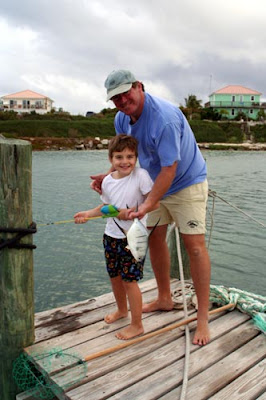
The trip to Rum Cay from the Exumas was a pleasant, if moonless overnight passage. We arrived late morning and threaded our way into the harbor. We were expecting a cold front to arrive on our heals so we decided on staying in the marina rather than in the anchorage, which we expected to be rolly and uncomfortable during the frontal passage.
Friday, February 25, 2011
Black Point, Great Guana Cay Exumas
Staniel Cay, Exumas
Saturday, February 19, 2011
Warderick Wells

Tuesday, February 15, 2011
Valentine's Day at Shroud Cay

Saturday, February 12, 2011
On to the Exumas
Yesterday afternoon we arrived in the Exumas after a wonderful 33 hour sail from Bimini. We left Bimini at dawn and motored south straight into 15 knots of wind. The waves were steep and right on the nose, but fortunately this was just for a few miles as we made our way to Gun Cay where we would turn East onto the shallow waters of the Great Bahamas Bank.
Once on the shallow smooth waters of the Great Bahamas Bank, we had wind on our beam. We shut off the motors and blew across the banks at 7-8.5 knots. It was a fantastic sailing day. With only 3 to 15 feet of water under our keel, I kept a close eye out for coral heads, but never had to change course to avoid them. We were following a route from the Explorer Chart Book and this is well traveled route we found it to be carefully plotted to avoid the hazards. I saw many coral heads on the banks, but all passed safely to either side of us.
I was very pleased with Mirasol’s performance. Even loaded down with every cabinet stuffed to overflowing with provisions and gear, we were able to overtake a monohull with a 10 mile lead and keep ahead of a larger catamaran following behind, although he would have overtaken us if he had a few more hours.
At sunset, we left the 6 to 20 foot water of the banks and entered the Tongue of the Ocean which is the deep water between the Great Bahamas Banks and New Providence. The drop-off is sudden – our depth finder which has a range of more than 350 feet and measures every second, lost the bottom with the last reading being 24 feet. A glance at the chart we were suddenly in 2600 feet of water, and would soon be in water over a mile deep. The topology of the Bahamian waters is simply amazing.
Over night, we sailed most of the way across the Tongue of the Ocean. The sky was clear and the moon was out so it was a bright passage. The wind settled down to about 8 knots, and we were fighting a 1.5 knot current so our progress was a modest 4.5 knots through the water and 3 knots over ground. It worked out just right, though as we arrived off of Paradise Island, New Providence just before dawn and would need daylight to pick our way onto the Yellow Banks just past New Providence.
As we approached New Providence, we could see the lights of the massive Atlantis Resort and other hotels on Paradise Island, and kept an eye out for the many passing cargo and cruise ships. At first light we picked our way through the scattered Cays and coral heads that guard the north east corner of New Providence and turned south onto the Yellow Banks. The Yellow Banks, like the Great Bahamas Bank is a huge expanse of very shallow water, generally less than 20 feet deep that runs the entire western length of the Exumas.
By mid afternoon on Friday we made Highborne Cay in the Exumas, which was where we had planned to anchor for the night. However, as we approached we learned that the cold front we expected to arrive the following evening had sped up and was now expected that night. The anchorage at Highborne Cay didn’t offer much protection from a strong North wind, so we changed plans and headed a couple hours further south to Shroud Cay.
The Shroud Cay anchorage is gorgeous, dotted with tiny cays surrounding Shroud Cay on the East and the turquoise waters of the Yellow Banks on the West. At Quinn’s suggestion, we toasted our arrival in the Exumas and then went about the business of squaring away Mirasol after a passage. By sunset the three of us were lounging on the bow, very happy to be back.
Exploring Bimini
We spent four days and five nights in Bimini at the Blue Water Marina while we waited for weather for our hop to the Exumas. We spent the time exploring Alice Town, building sand forts on the beach, fishing off the boat and a little minor boat maintenance here and there.
We had arrived on the Saturday before Super Bowl Sunday and Jen was happy to find that the owners of The Big Game Club marina were big Packers fans and were hosting a Super Bowl BBQ. Late Sunday afternoon we headed for the Big Game Club, both Jen and Quinn sporting their Packer gear. Since the Bears didn’t make it, I settled for cheering for the Packers, but refused to wear any Packers gear. The waitress at the door harassed me a bit for being a Bears fan, but let me in anyway. The BBQ was fantastic. Jen went for the chicken, Quinn for the ribs and I for the jerked pork loin. Delicious! Bahamians know how to throw a BBQ! Since the Packers won the big game, we celebrated with a big slice of chocolate cake, probably the last desert of that type we’ll find for a few months.
Monday Jen went searching for sea glass while Quinn and I built a huge sand fortress, complete with an outer wall, a moat, and a secret escape tunnel in the back. It has been many months since Quinn’s been on a beach like this and he put it to good use!
Alice Town was a pleasant place to visit, with very friendly locals. Quinn made several friends, including Craig, the BBQ master & bartender at the Big Game Club. The town is well kept and painted bright pinks, blues, and yellows. I was sorry to find that the Complete Angler Hotel where Hemmingway spent a lot of time had burnt down in 2007. Maybe I’ll read Old Man and the Sea again soon.
Arrival In Bimini
We’re back in the Bahamas!
The crossing from Miami to Bimini was bouncy but pretty quick. We were in a pack of six boats making for various entrance ports of the Bahamas so we had plenty of company. We worked our way slowly through the pack and were the first of the three boats to arrive at Bimini. Not that it was a race…
On arrival at the cut between North and South Bimini, we found that the entrance did not resemble our electronic or paper charts. There were two large brand new channel buoys that were not on our charts and none of the buoys that were on our charts. The only thing that seemed in agreement was the note about shifting sand bars on the charts and the breakers we were seeing just beyond those fancy new buoys. We motored very slowly between the entrance buoys and confirmed the water in front of us was full of breakers so we turned around and headed back out to deep water to regroup and visually plan our route in.
We were hailed by another boat that just arrived who wanted to know what we found in the cut. They had been here before, but said the markers were all new. They had waypoints plotted from their last visit, so we let them lead the way. As we headed in, we were hailed by someone with local knowledge who advised us to ignore the new buoys and head straight towards the southern shore and follow the beach in through the cut. On the bow, Jen said that route looked the best and we headed that way. The boat we were following didn’t heed these instructions, I assume being more comfortable with their old waypoints, and ran afoul of one of the sandbars. They were being very cautious so didn’t ground hard and were quickly moving again. We both then followed the beach in through the cut and were safely in the North Bimini channel off of Alice Town.
We took a slip in Blue Water Marina, cleared Bahamas Customs and Immigration, and settled in for a relaxing evening.